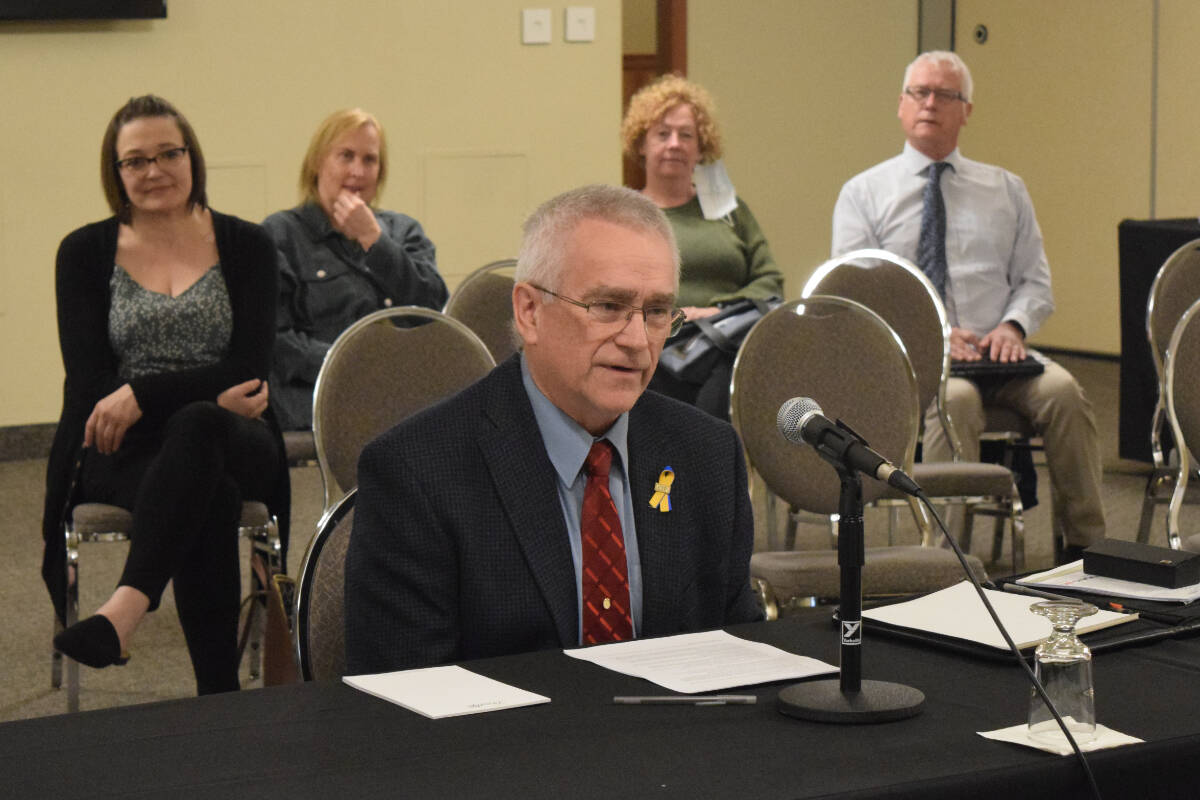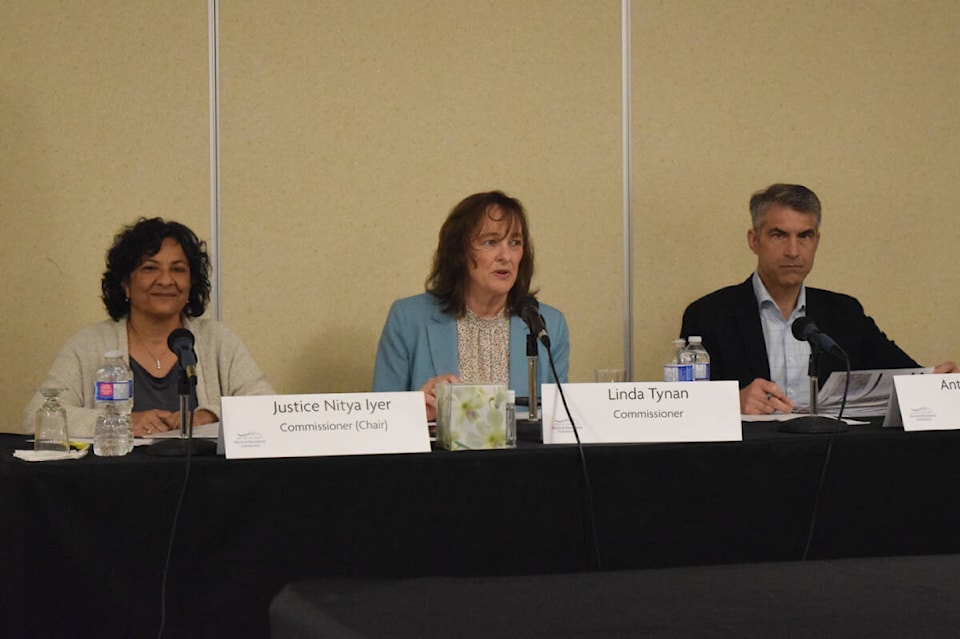The B.C. Electoral Boundaries Commission (EBC) heard just two presentations at a public meeting in Smithers April 28, both advocating to maintain the status quo for the Stikine riding.
The three-member commission is charged with reviewing existing electoral district boundaries and making recommendations to the Legislature on redistricting based on a number of principles.
Primary among these is the principle of representation by population. By legislation, when recommending boundaries, the commission must not deviate more than 25 per cent from a statistical population mean except “where it considers that very special circumstances exist.”
At the Hudson Bay Lodge last Thursday, former Stikine MLA Doug Donaldson and Smithers town councillor Lorne Benson made the case to the panel that those very special circumstances exist in the Stikine riding.
Currently, Stikine, with a population of 20,240, deviates from the mean (57,000) by 55 per cent.
In arguing for the preservation of the current riding, Donaldson noted it is geographically the largest in the province, stretching from south of Telkwa to the Yukon border.
READ MORE: B.C. Electoral Boundaries Commission seeks input from northerners
To illustrate the difficulty of representing the admittedly small population, the former MLA noted his then-colleague Spencer Herbert, who represents Vancouver West-End, could walk his entire riding in 45 minutes.
Donaldson, on the other hand, to get from one end of Stikine to the other, would have to drive 45 minutes from Hazelton to Smithers, get on a plane to Vancouver, fly from there to Whitehorse, rent a car, and drive two hours to visit Atlin, the northernmost community in the district on the west side. However, the total elapsed time of nine hours was still better than the 16 it would have taken him to drive from Hazelton to Atlin, he said.
It was a similar, but even longer, ordeal to get to Lower Post, another small Indigenous community near the Yukon border on the east side of the riding.
Without visiting those communities, Donaldson explained that he never would have been able to effectively represent the constituents who live there. On his first trip to Lower Post, Donaldson discovered the band offices were located in the former residential school.
There, where it had actually happened, he was told horror stories of the physical and sexual abuse survivors had experienced.
“So by listening, and by that in-person relationship, I was able to tell that story in the Legislature and subsequently, when we formed government, Premier Horgan visited the community and subsequent to that, that building was torn down and the new band office is being built,” he explained. “And so, without that ability to access their MLA and for me to learn from them it would be very difficult to tell that story in Victoria and end up with the results that we ended up with.”
Donaldson also argued the complexity of lower-level governance over such a large and sparsely populated geographic area warranted recognition of the very special circumstances the MLA must deal with.
He pointed out to the commissioners that Stikine incorporates five municipalities, 13 unincorporated communities, 13 First Nation villages, six First Nation traditional territories (many with their own strong traditional governance systems), three school districts, 10 private schools and two regional districts.
Donaldson concluded that reducing representation in the north, even if it is just by increasing the number of districts in other regions, would be detrimental to effective representation for rural and remote ridings.
”I’m going to flip the argument that maybe you’re hearing from urban dwellers,” he said. “What that would amount to is a watering down of northern and remote rural representation by adding more seats in suburban and urban areas.
“I’m thinking in these times, the divisiveness, the feeling of alienation, the polarization of people that are not in power centres in Victoria and elsewhere, but in remote, rural communities could be exacerbated by decreasing who they see represents them in the legislature and represents their views.”
Supreme Court Justice Nitya Iyer, commission chair, said the message she and the other commissioners — Linda Tynan, a local government management consultant; and Anton Boegman, B.C.’s chief electoral officer — heard in Smithers is similar to what they’ve heard in northern and other rural and remote ridings in the province.
She said that is going to be a challenge considering 2021 legislation that removed protection for rural ridings.
In 2014, the Liberal government of Premier Christy Clark established three regions, the North, the Cariboo-Thompson and Columbia-Kootenay for which the number of seats could not be reduced regardless of population. Currently, there are eight in the North,
In 2021, the NDP government amended that act under the auspices of “restoring independence to electoral boundaries commissions.”
“The fact that the legislation that previously created the protected regions, and the protected electoral districts, has been amended, again, to remove them means that we have to face that issue,” Iyer said. “And the only guidance we have is the current legislation. So… it’s a bit of a roundabout answer, but we know this is going to be a challenge. We want to hear different perspectives on it.”
Benson, speaking on behalf of Smithers Mayor Gladys Atrill, echoed many of Donaldson’s points on population, demographics and complexity of governance, but added some other complexities he believes warrant consideration of special circumstances for the preservation of northern districts.
“I would suggest, as with any other considerations, that some continuity in terms of representation of First Nations’ interests should be a consideration, particularly in light of issues around reconciliation today,” he said.
“Each of these nations has their own unique form of governance, their own regional resource agreements that they’re putting in place or have in place and there’s nuances and complexity to these relationships that are long-established and continuing to develop,” he said. “I think when you have continuity of representation in Victoria to give consideration to these nuances, you’re potentially going to see better results, certainly less potential for conflict or confusion, that sort of thing.”
Benson also added other regionally shared complexities and nuances such as resource development, healthcare and schools as an impetus for continuity in the electoral boundaries.
By legislation, the EBC could add up to six new ridings to the B.C. electoral map.
Iyer said she had not heard of any proposals to add northern ridings, but acknowledged adding ridings elsewhere would effectively dilute northern representation.
She strongly encouraged all citizens who have an opinion on the issue to make a submission to the commission, which can be done in a variety of ways. She said they have received more than 600 to date.
The panel will be continuing its public consultation both in-person and virtually throughout the spring and hopes to have a preliminary report by fall.
The commission is required to present its final recommendations to the Legislature by April 2023.
The Legislature is not bound in any way to accept all or any of the recommendations.
editor@interior-news.com
Like us on Facebook and follow us on Twitter

